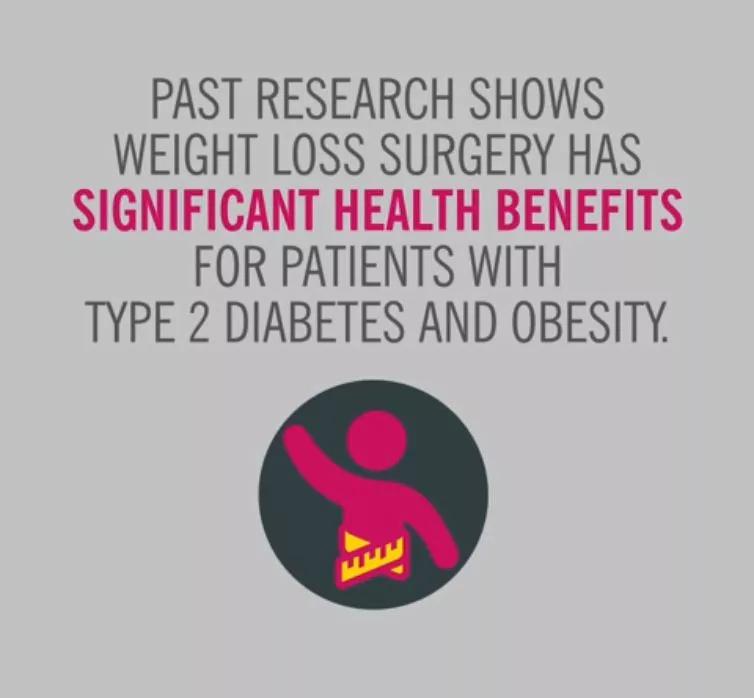Personalized score can inform patients who are considering weight-loss surgery
Content is property of Cleveland Clinic and for news media use only.


Patients struggling with type 2 diabetes and obesity are faced with the decision of whether to receive usual medical care or undergo weight-loss surgery. Now, a new risk calculator developed by Cleveland Clinic researchers can show these patients their risks of developing major health complications over the next 10 years depending on which course of treatment they choose.
The research was presented today as one of the Top 10 studies at the ObesityWeek 2019 international conference in Las Vegas.
Research has shown that weight-loss surgery – also known as metabolic or bariatric surgery – can help people control their diabetes and improve cardiovascular health. In 2016, the world’s leading diabetes organizations recommended in a consensus report that metabolic surgery should be a treatment option for people with type 2 diabetes and obesity. However, few eligible patients undergo the surgery.
To help patients and their physicians better predict the health benefits of usual care versus surgical treatment, Ali Aminian, M.D., a bariatric surgeon at Cleveland Clinic, and his research team developed a risk score calculator that provides personalized evidence-based information, based on a patient’s current health status.
“The calculator can be a useful tool for physicians and patients with type 2 diabetes and obesity. It shows a patient’s risk of heart disease, stroke, heart failure, diabetic kidney disease, and death over the next 10 years with usual care. It also shows how a patient’s risk of those adverse events could change after metabolic surgery,” said Dr. Aminian, who is also lead author of the study.

The calculator — 10-year Individualized Diabetes Complications Risk Scores — was developed in two phases over the course of about two years. In the first phase, an observational study looked at nearly 2,300 patients who underwent metabolic surgery and 11,500 matched patients with similar characteristics who received usual medical care.
Thephase 1 results, published in the Journal of the American Medical Association (JAMA) in September, show that weight-loss surgery performed in patients with type 2 diabetes and obesity is associated with 40% lower risk of death and major adverse cardiovascular events than usual medical care. Surgical patients also lost more weight, had better diabetes control, and used fewer medications for treatment of their diabetes and cardiovascular disease than those undergoing usual medical care.
In phase 2, the researchers used the same group of patients to identify predictors for different health outcomes. Evidence-based models were built and integrated into a risk calculator to estimate the likelihood of coronary heart disease, stroke, heart failure, diabetic kidney disease, and mortality over the next 10 years in patients with type 2 diabetes and obesity with and without bariatric surgery
“Based on the advice of subject matter experts, our team was able to explore 26 risk factors for the different outcomes, including risk of dying, in that large group of patients,” said Michael Kattan, Ph.D., chairman of the Department of Quantitative Health Sciences in Cleveland Clinic’s Lerner Research Institute. “We then compared machine learning and traditional statistical techniques to identify the most accurate prediction models for each outcome and built those into the calculator.”
Steven Nissen, M.D., Chief Academic Officer of the Heart & Vascular Institute at Cleveland Clinic, added, “Diabetes can be a devastating disease and combined with obesity, patients are at a high risk for cardiovascular complications. Metabolic surgery is an underutilized treatment for these patients. This calculator can help both physicians and patients quantify the risks and benefits of surgery and make the best decision for treatment.”
The calculator will be accessible on the Cleveland Clinic Risk Calculator Library website and as a smartphone application (BariatricCalc). The second version of the app with additional calculators will be released during ObesityWeek 2019.
This study was partially funded by an unrestricted grant from Medtronic. Medtronic had no role in the design, conduct of the study, or reporting of the results.
Cleveland Clinic is a nonprofit multispecialty academic medical center that integrates clinical and hospital care with research and education. Located in Cleveland, Ohio, it was founded in 1921 by four renowned physicians with a vision of providing outstanding patient care based upon the principles of cooperation, compassion and innovation. Cleveland Clinic has pioneered many medical breakthroughs, including coronary artery bypass surgery and the first face transplant in the United States. Cleveland Clinic is consistently recognized in the U.S. and throughout the world for its expertise and care. Among Cleveland Clinic’s 82,600 employees worldwide are more than 5,786 salaried physicians and researchers, and 20,700 registered nurses and advanced practice providers, representing 140 medical specialties and subspecialties. Cleveland Clinic is a 6,728-bed health system that includes a 173-acre main campus near downtown Cleveland, 23 hospitals, 280 outpatient facilities, including locations in northeast Ohio; Florida; Las Vegas, Nevada; Toronto, Canada; Abu Dhabi, UAE; and London, England. In 2024, there were 15.7 million outpatient encounters, 333,000 hospital admissions and observations, and 320,000 surgeries and procedures throughout Cleveland Clinic’s health system. Patients came for treatment from every state and 112 countries. Visit us at clevelandclinic.org. Follow us at x.com/CleClinicNews. News and resources are available at newsroom.clevelandclinic.org.
Editor’s Note: Cleveland Clinic News Service is available to provide broadcast-quality interviews and B-roll upon request.